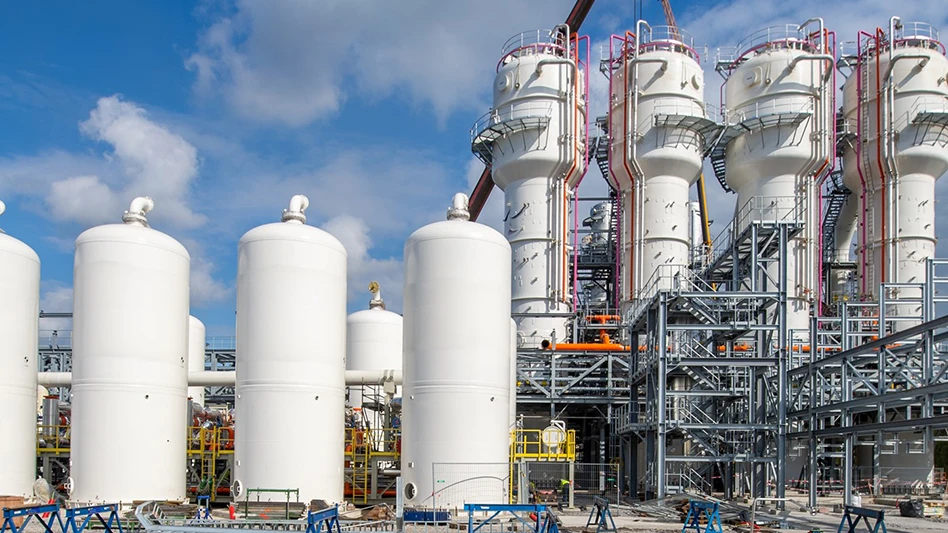
Photo courtesy of ArcelorMittal
Luxembourg-based ArcelorMittal and Illinois-based LanzaTech Global Inc. say they have produced their first ethanol samples from a commercial flagship carbon capture and utilization (CCU) facility in Ghent, Belgium.
The $215 million “Steelanol” facility is being called the first of its kind for the European steel industry. ArelorMittal says LanzaTech’s carbon recycling process couples decarbonization technology with chemical production to advance the circular economy.
“This week saw the first step toward full operation of a commercial scale facility that will capture carbon-rich waste gases from steelmaking and biologically convert them into advanced ethanol through LanzaTech’s bio-based process,” the steelmaker says.
ArcelorMittal says, unlike traditional fermentation, the process ferments gases instead of sugars and uses a biocatalyst instead of yeast. In May, the first gases from the steel mill’s blast furnace were introduced to LanzaTech’s biocatalyst.
“After a successful inoculation, initial samples that contained ethanol were produced this week, demonstrating that the carbon in the gases is being converted into new chemical products,” ArcelorMittal says.
The firms say commercial-scale ethanol production from the bioreactors will follow, with expected ramp up of production in upcoming months. The Steelanol facility is expected to reach full operational capacity before the end of the year, according to ArcelorMittal.
The ethanol produced can be used as a building block to produce a variety of products, including sustainable transport fuels, packaging materials, apparel and even cosmetic fragrances, ArcelorMittal says, adding that the Steelanol plant has an annual capacity of 80 million liters (21.1 million gallons) of ethanol, around half of the total current demand in Belgium.
Recycling of carbon means Steelanol’s process of Carbalyst-branded ethanol production does not compete in any way with food crops, as is the case for many other methods of ethanol production, the steelmaker adds.
The technology could reduce carbon emissions from the Ghent plant by 125,000 metric tons annually. “The product samples from the facility this week mark an important step toward the circular use of carbon and the end of single-use carbon, whereby gases are no longer regarded as waste but as raw materials,” states ArcelorMittal.
“ArcelorMittal has long been a leader in decarbonization of the steel industry, and today we are delighted to announce the first product samples from the Steelanol plant,” LanzaTech CEO Jennifer Holmgren says. “To many people, using CCU to capture emissions to make everyday products seems like science fiction, but we have shown the world what is possible at industrial scale today.”
“ArcelorMittal has a passion for sustainability and circularity and has found the right partner in LanzaTech to realize that today," ArcelorMittal CEO Manfred Van Vlierberghe adds. "The beauty of the Steelanol facility is that we are enabling a new form of industrial symbiosis, connecting industries together by using gases from steel production as a feedstock for other sectors.”
Other project partners include London-based Primetals Technologies and London-based consultancy E4tech, with support from the Brussels-based European Climate, Infrastructure and Environment Executive Agency (CINEA).
"LanzaTech, ArcelorMittal, Primetals and E4Tech have worked together and have been supported by CINEA, to create a vision of a new circular carbon economy in Europe, displacing fossil carbon from the ground," Holmgren says.
Funding for the commercial Steelanol facility was obtained from various sources, including the Flemish government, the Belgian federal government, the European Union’s Horizon 2020 research and innovation program and a loan from the European Investment Bank.
Latest from Recycling Today
- Nucor receives West Virginia funding assist
- Ferrous market ends 2024 in familiar rut
- Aqua Metals secures $1.5M loan, reports operational strides
- AF&PA urges veto of NY bill
- Aluminum Association includes recycling among 2025 policy priorities
- AISI applauds waterways spending bill
- Lux Research questions hydrogen’s transportation role
- Sonoco selling thermoformed, flexible packaging business to Toppan for $1.8B





